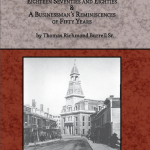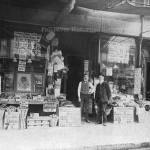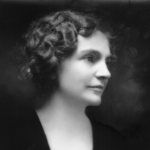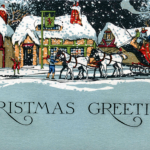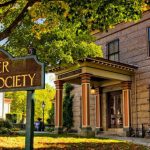During the 19th and well into the 20th centuries, scores of talented seamstresses from every ethnic background worked privately as dressmakers in Fall River; maintaining workrooms in their homes, some of these industrious women developed lucrative businesses, with a coterie of loyal clients. From alterations of existing garments to creating clothing from commercial patterns or original designs, they plied their trade one stitch at a time, supplementing the family income or, in some cases, being the primary breadwinner.
Most often they are completely unknown – cogs in the wheel of fashion – and surviving examples of their work are the only evidence of their prowess with the needle; labels were rarely applied to garments.
Some women employed small staffs of assistants, or recruited daughters and other relatives, but the vast majority operated single-person shops and did it all, from measurements and cutting, to stitching and trimming – they were the première, the draper, the vandeuse, and, no doubt, the confidante, sagely offering fashion tips and the occasional reassuring word:
“Non, non, Madame is not thickening in de waist. But I think we tighten de corset a bit. Yes?”
The FRHS maintains an extensive collection of clothing and accessories dating from the 18th to the mid-20th centuries – many sans label or tag – causing one often to wonder about the identity of the anonymous seamstress who made the garment.
A recent donation to the FRHS collection sheds light on the identity of one Fall River dressmaker, Alphonsine Hardy née Boutin (1894-1969); she undoubtedly held a needle for the majority of her life.
Alphonsine was born in Fall River to parents of French Canadian ancestry and was the eldest of nine children. Her father, Oliver Boutin (1866-1914), was a Vermont native, employed in the city as a molder, and her mother, the former Olivine Joly (1869-1951), had emigrated from Canada in 1879; they were married at St. Anne’s Church on April 17, 1893.
Olivine was a skilled dressmaker and maintained a workroom in her home; although she was likely employed in that capacity the majority of her life, she was independently listed in the Fall River city directories in that occupation for a twenty-three year period from 1913 to 1936. The 1910 Federal Census lists her occupation as “dressmaker,” indicating that she was engaged in that trade in the years before her directory listings. The scenario is sensible: Most private dressmakers did not advertise nor list their occupations as such, word of mouth and recommendations from existing clients being the only form of promotion necessary.
Alphonsine, undoubtedly, served her apprenticeship in the workroom de sa mère, being raised surrounded by the tools and the cacophony of the trade, which would have been ever-present throughout the house: The rhythmic hum of the sewing machine trestle; the snip of the scissors; or the distinct, crisp sound of razor sharp blades ripping through fabric.
That sound I know to be true: My mother was a dressmaker, and I grew up in similar fashion. My mother’s sewing machine was, of course, powered by electricity, but my paternal grandmother used her trestle-driven machine – a Singer housed in a quartered oak cabinet – throughout my childhood. I can still hear their echoes.
As a very young child, Alphonsine was likely first enlisted to pick up dropped pins – they were costly, and could not be wasted – and as soon as she was able, was handed the needle, taught to thread it, and made to practice countless stitches by rote on scraps of fabric. The simple, mundane tasks of her youth led to those that required more skill: As childhood passed to adolescence and, in turn, to young womanhood, she developed into an accomplished seamstress. The ability to “feel” fabric with her eyes to judge its quality – a surefire attribute of any expert dressmaker – would have gradually developed over time.
By the time of her marriage to David Eugene Hardy in 1918, she had mastered the trade, and shortly thereafter began working from her own home as a dressmaker, an occupation in which she would be engaged for the remainder of her life.
Fashion was an integral part of her being and she drew inspiration from countless sources – a granddaughter recalled that she visited Boston, Massachusetts, fashion shows to sketch the latest models, which she would copy or adjust to her own design. During particularly busy times, or when undertaking an important commission – a wedding gown, for example – women with specific skillsets were hired to assist with the work. As an example of history inevitably repeating itself, her daughters “were roped into helping at times,” much as she had been with her mother, years before.
During her long career, Alphonsine witnessed dramatic changes in fashion: From the Gibson Girl silhouette of her youth to the mini-skirts of the 1960s, she saw – and worked – on them all.
Aware that self-marketing was important, she was well-dressed; au courant with the latest fashions, she chose a version of a robes de style for a garment she made for her personal wardrobe in the 1920s, created in a popular color combination of coral and black.
The garçonne-style boxy chemise dress indicative of the Roaring Twenties flapper was ill suited to many women, a fashion dilemma addressed by the legendary French designer Jeanne Lanvin (1867-1946), who introduced the robes-de-style. The design featured a close-fit bodice and a fuller skirt – the overall fullness and length varied widely – that was better suited to women of all ages and more forgiving to figures; it was embraced by Jazz Age daughters and their elders alike.
Howard Carter’s 1922 discovery of the tomb of the pharaoh Tutankhamun set off an Egyptian-Revival craze that dominated the decade – among the fashionable Art Deco color combinations inspired by this renowned archaeological find was that of coral and black, with the rich, reddish-orange hue striking against the timeless, sophisticated elegance of black.
Cut from silky black rayon satin, Alphonsine’s dress features a dropped waist, and skirt that falls in soft folds; simple panniers at the hip, consisting of a single hoop each, provide the desired fullness, resulting in slightly cascading folds. The bodice is heavily encrusted with glass beads featuring large chrysanthemum-like blossoms in coral – the petals are composed of a double row of beads – centered with black, and surrounded by an overall pattern of meandering scrolls, reminiscent of stylized foliage. The pattern is repeated along the hemline. The light, reflecting from the mirror-like surface of coral and black glass beads, was dazzling, glistening with her every movement.
She completed the ensemble with an airy boa of coral-dyed ostrich feathers, and an impressive aigrette of curved black feathers, artistically stripped of select plumage for dramatic effect. We know nothing of her handbag or shoes – sophisticated French heeled strapped pumps, perhaps? – but can easily imagine that they were very carefully selected.
Fashionably dressed and perfectly accessorized, Alphonsine surely made a statement as an elegant woman of style.
The garment has survived in excellent condition and requires only minor conservation in the form of reattaching a few small areas of lose beadwork; remarkably, the extremely fragile feather boa and aigrette have also been preserved in near-pristine condition, and are rare survivors of the era.
The FRHS is pleased to add this 1920s ensemble to the its collection of costumes and accessories and thanks Alphonsine’s daughter and granddaughter for sending the items “home” to Fall River.
This garment exemplifies the work of a heretofore obscure Fall River dressmaker, and serves to document one aspect of the city’s French-Canadian cultural heritage.



